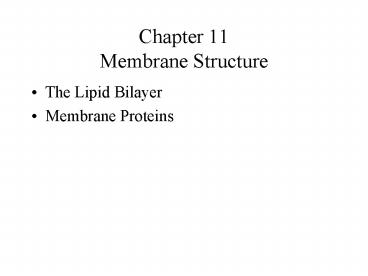Chapter 11 Membrane Structure - PowerPoint PPT Presentation
1 / 17
Title:
Chapter 11 Membrane Structure
Description:
a barrier preventing cell content to escape. nutrients going in. waste ... Cell membrane is composed of a lipid bilayer ... Phosphatidyl choline-the most ... – PowerPoint PPT presentation
Number of Views:148
Avg rating:3.0/5.0
Title: Chapter 11 Membrane Structure
1
Chapter 11Membrane Structure
- The Lipid Bilayer
- Membrane Proteins
2
- Function of a membrane
- a barrier preventing cell content to escape
- nutrients going in
- waste products going out
- Sensors
- Signals to turn on/off genes
- Movement and expansion
- Some organelles are separated by membranes
- ER, Golgi, mitochondria and others
- Fig 11-1, -2, -3
3
- Cell membrane is composed of a lipid bilayer with
embedded proteins - Membrane lipids are composed of
- A hydrophobic tail (hydrocarbons)
- A hydrophilic head (lipids)
- Fig 11-4, -5
4
- Phosphatidyl choline-the most abundant
phospholipid - Its hydrophilic part is a choline molecule
attached to a phosphate - A hydrophobic part consists of hydrocarbon chains
- Fig 11-6
5
- Examples of other membrane lipids, which are
amphiphatic molecules - Phosphatidylserine
- Cholesterol
- Galactoserebroside
- Fig 11-7
6
- Triacylglycerol-hydrophobic only, in water will
form a large drop - Phospholipid-amphiphatic molecule, in water will
form a bilayer - A bilayer will assemble itself
- Tear in a membrane is energetically unfavorable
- A bilayer will spontaneously rearrange and seal
itself - Membrane is of a fluid nature and in constant
movement - Fig 11-10, -11, -12, -13
7
- Phospholipids move within the plane of the
membrane-rotation and flexion - Enzymes called flippases will transfer
phospholipid to the opposite monolayer (occurs
very rarely) - Fig 11-15
8
- Saturated fatty acids-the hydrocarbon tail has
single bonds only - Unsaturated fatty acids
- double bonds are present (does not contain the
maximum of hydrogen bonds) - each double bond creates a kink
- the more kinks the more the membrane is fluid
- Cholesterol
- Hydrophilic group (polar OH) and a hydrophobic
tail - Presence of cholesterol in a membrane controls
its fluidity-the more cholesterol in the membrane
the more rigid it becomes - Fig 11-16
9
- The lipid bilayer is asymmetrical
- Different selection of phospholipids and
glycolipids are facing inside and outside of the
cell - Formation of a lipid bilayer is
- rapid and spontaneous in water
- Hydrophobic interactions are the major driving
force - Hydrocarbon tails van der Waals forces
- Hydrogen bonds between polar heads and water
molecules - Fig 11-17
10
Membrane ProteinsFunction
- Allow for transport in/out of the cell
- Anchors the membrane to other macromolecules
- Receptors, ability to detect external signal
- Catalyze reactions
- Fig 11-20
11
- Proteins in lipid bilayer-types of association
- Transmembrane proteins-pass through the bilayer
- Membrane associated-entirely in cytosol,
associated with the inner membrane - Outside of the bilayer-covalently linked to the
bilayer lipids - Attached to other membrane proteins by
non-covalent bonds - Fig 11-21, 11-23
12
- Aqueous pores allow water soluble molecules to
cross the membrane - 5 transmembrane helices form a water filled
channel - Hydrophilic amino acids are in the middle of the
aqueous channel - Hydrophobic amino acids are on the outside
- Fig 11-24
13
- Beta barrel
- Formed from beta sheets
- Porin proteins-aqueous channel
- Fig 11-25, -26, -27
14
- Bacteriorhodopsin-a membrane transport protein
which is a photosynthetic reaction center - Found in archaebacterium Halobacterium
- Utilizes sunlight
- Composed of retinal covalently attached to one of
the 7 alpha helices - Membrane transport protein that pumps hydrogen
ions outside of the cell and generates excess of
H ions outside of the cell - Hydrogen ions flow back to the cell and the ATP
is generated - Fig 11-28
15
- Photosynthetic reaction center of the bacterium
Rhodopseudomonas captures energy from sunlight - A large complex composed of 3 transmembrane
proteins bound to the fourth protein, cytochrome - This complex utilizes light energy absorbed by
chlorophyll and produces high energy electrons
required for photosynthetic reactions - Fig 11-29
16
- Carbohydrates on the outer cell surface
- Glycoproteins-carbohydrates covalently linked to
proteins - Glycolipids-carbohydrates covalently linked to
lipids - Fig 11-32
17
- Function of glycolipids on the cell surface
- Inflammatory response
- Carbohydrate on the surface of neutrophils (WBC)
is recognized by lectin (transmembrane protein in
the endothelial cells lining blood vessels) - Neutrophils adhere to the blood vessels and
migrate to the site of inflammation - Fig 11-23































